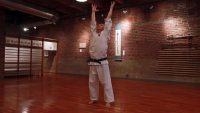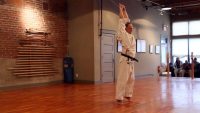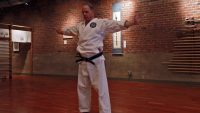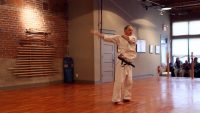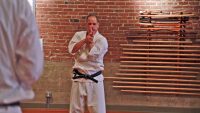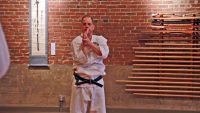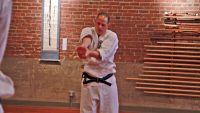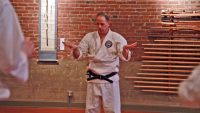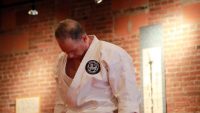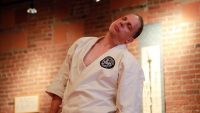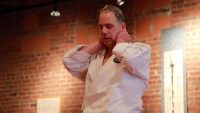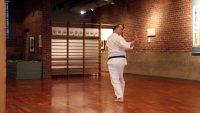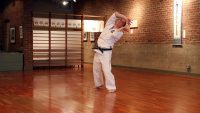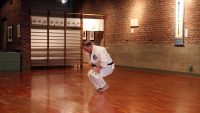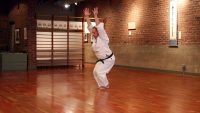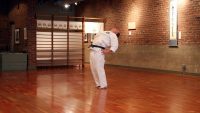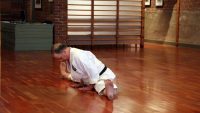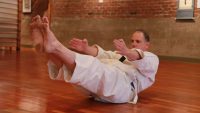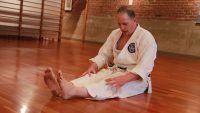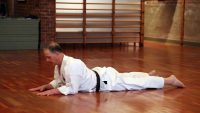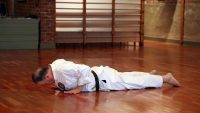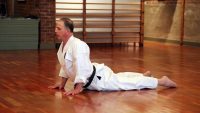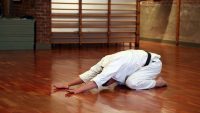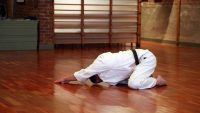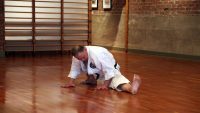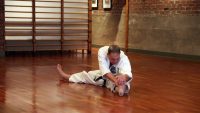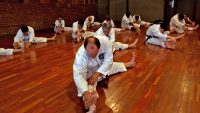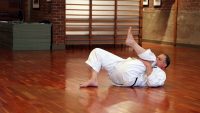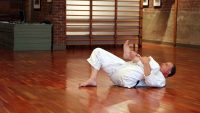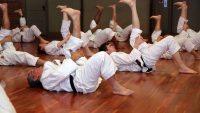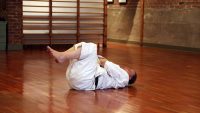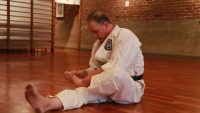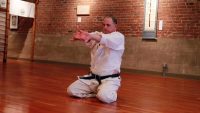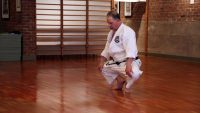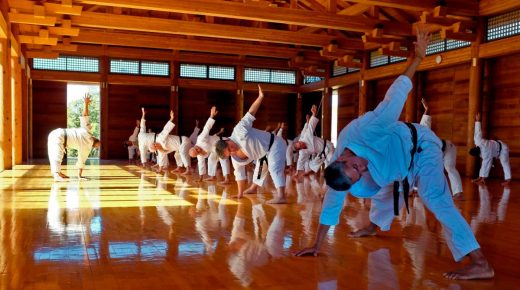
David Altman leads warm-up and stretching during godan practice at Shotokan Ohshima Dojo near Santa Barbara, California Nov 2, 2014
The Importance of Warming up, stretching, and Cooling Down
On several occasions, Ohshima Sensei has asked me to lead warm-ups, most recently at the 2014 yodan and godan practices at Shotokan Ohshima Dojo. My face flushed a little when Mr. Ohshima praised those warm-ups to the group, but afterward many members asked me to explain my approach to flexibility training. Although I don’t consider myself to be an expert, I agreed to do my best to communicate what I’ve learned.
My approach to warm-ups and stretching may seem a little different than you are accustomed to in practices, but this is not in any way a criticism of other methods. My practice has grown out of the teachings of all my seniors who paved the way and continue to lead sincerely and with all their hearts.
 I was sixteen years old in 1976. I’d been training to break the world record in jumping rope. Every day I warmed up and stretched for an hour before I began jumping rope. I never missed a day. Jon Beltram noticed me while I was jumping rope day after day at the gym where he also worked out. Eventually he invited me to come to karate practice with him in the basement of a Catholic church. Although my rope-jumping record was broken almost immediately, I’ve never stopped practicing karate. I am so deeply indebted to Jon for training me these past 39 years, for his leadership, his unconditional friendship, and for introducing me to Ohshima Sensei and other SKA seniors and members.
I was sixteen years old in 1976. I’d been training to break the world record in jumping rope. Every day I warmed up and stretched for an hour before I began jumping rope. I never missed a day. Jon Beltram noticed me while I was jumping rope day after day at the gym where he also worked out. Eventually he invited me to come to karate practice with him in the basement of a Catholic church. Although my rope-jumping record was broken almost immediately, I’ve never stopped practicing karate. I am so deeply indebted to Jon for training me these past 39 years, for his leadership, his unconditional friendship, and for introducing me to Ohshima Sensei and other SKA seniors and members.
My college degree was Biomechanics, with a focus on working with people with disabilities. I worked as a massage therapist for several years, but for almost my entire career, I’ve been employed by the State of Nebraska to assist the disabled. I love helping people!
In spite of my formal training and my profession, I didn’t truly begin to understand stretching until my wife and I started practicing yoga about 20 years ago. Like karate, yoga is an ancient art, which at its core, is about freeing ourselves from mental and physical blocks. Most of our traditional karate warm-up is based on yoga exercises.
Junbi Undo:
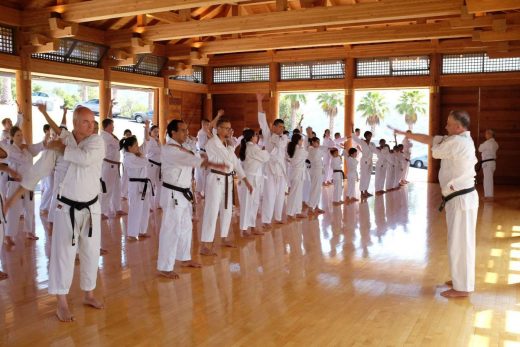
Stretching at the start of the after-Nisei Week practice at Shotokan Ohshima Dojo near Santa Barbara, California in August, 2014
Junbi Undo (準備運動) means “warm-up exercise.” These are preliminary exercises to awaken the mind and body in preparation for practice. Warming up increases respiration, heart rate, circulation, and warms the musculature, tendons, ligaments and the synovial fluid in the joints. Breathing is the main tool to release tension from the body. Releasing tension allows us to safely begin stretching the musculature, and opening up the ligaments, tendons, and joints.
Junbi Undo is not just something we do before practice; it is an important part of our practice. It allows us to move freely, and to connect our breathing, mind, and body as one. We must study and understand how and why to perform the movements of warming up, stretching, and cooling down, and how they relate to martial arts. This can help us gain additional insight into our practice of budo.
One of the main points of warming up, stretching, and cooling down is kokyū (呼吸), breathing. In our practice, the word “breathing” doesn’t refer only to respiration; it means more than that. We try to create some heat in our bodies, and intention through breathing. When we stretch and breathe in (inhale) we are trying to find more space, when we breathe out (exhale), we relax, yield to the earth and let go. Breathing is the main tool to release the tension in our bodies. We can’t relax without breathing, and we can’t breathe without relaxing. In order for our muscles to relax, we must hold a stretch while we direct our breathing through that area. A key is not to go too fast or to move robotically from one exercise to the next.
Most of us are accustomed to a pre-practice routine that is more warming up than stretching. I think it is vital to our practice that we do both, plus a cool down at the end of practice.
My warm-up and stretching sequence is a little different each time, depending on the conditions. I incorporate different movements and postures from my yoga practice. I start with smaller muscle groups and move to larger ones, and tailor the warm-up and stretching to the activity we will be doing. For instance, at Special Training, before kibadachi or kicking practice, I concentrate on the legs. Of course, it is still important to warm up and stretch other parts. After practice we can benefit the most from stretching, because we’re already really warm.
I want to keep my focus on helping to improve the way we do junbi undo, to help us to stay healthy in our practice and to reduce injuries.
There are different kinds of stretching including:
- ballistic (i.e. bouncing, not considered useful)
- dynamic (gradually increasing reach and/or speed)
- static (holding a stretch position)
- active (holding a stretch position using only agonist muscles)
- passive (holding a relaxed stretch position with assistance)
- isometric (holding a stretch position while tensing the stretched muscles)
- PNF (proprioceptive neuromuscular facilitation, alternating passive with isometric)
One word of caution: Many experts say that static stretching of cold muscles can damage your body. I think this is true and that we need to study this more to find the best combination. Dynamic stretching involves movements that jumpstart range of motion, making them a great warm-up solution. Consistent stretching is key to increasing flexibility, range of motion, and potentially reducing the risk of muscle strain.
Some people won’t be able to perform all of these movements because of limitations due to injuries or physical problems. Any of these exercises can and should be modified as needed by each person. For instance, if someone has really bad knees, hips, ankles or back problems, they shouldn’t jump up and down. For those who can jump, jumping should be done lightly in order to reduce the shock of landing and avoid reverberating that shock into the joints.
There are so many types of exercises I practice routinely that I’m unable to write exactly what I do. My routine changes a bit each time, according to my sense of the participants and conditions, so this will be a general outline. I would also take into consideration about how much time you take to lead flexibility training.
November 15, 2014 video (34:47) shows one of David Altman’s junbi undo warm-up and stretching exercises in entirety (video shot by Molly Garett, Lien Phan, & Mike Lyon, produced and edited by Mike Lyon).
Warm-up:
Opening up your body takes time and patience. Don’t be in a hurry. Practice is life and life is practice.
Dynamic warm-up: run in place, fake jump rope, jump up and down, jumping jacks, all must land lightly; light punching or front kicks. You are trying to increase circulation, respiration, and warm up the musculature/tendons/ligaments and synovial fluid in your joints. If one can’t do the exercise, then modify to taste. Just moving your arms and bending your knees up and down continuously is effective.
Arm, shoulder, and wrist exercises:
- Stretch arms up to the sky, lengthen the body, and keep reaching.
- Keep arms reaching up, grab one wrist and move upper torso over to one side, keep reaching up and over, ground opposite foot to earth, then switch sides, breathe through the area you are concentrating on, breathe through your side waist.
- Warm up the shoulders with small arm circles, 4 sets of 30. While performing the arm circles, position wrists up, forward and backward 30 times each, and wrists down, forward and backward 30 times each.
- Move arms up and hold (most people are not used to this). This fatigues the shoulder girdle and relaxes that area (this helps in learning to eliminate conscious power from the shoulders).
- Reach one arm upward, and then drop down the middle of the back. Gently place the other hand on the dropped elbow and lightly encourage the shoulder and triceps to open. Then release and bring the arm across the chest, relax and drop the shoulder, and pull the arm across the body. Feel the muscles relax. Then move the arm up and start to wrap it around the neck, keeping the shoulder down. Pull the arm across the body. Feel how this stretches the arm differently. Do the same sequence on the other side.
- Put one hand on the opposite shoulder. Then start to rotate that arm around (slowly) through the limits of the range of motion in a full circle. Do that 3 or 4 times, and then do the same rotation in reverse. Supporting the shoulder helps remind that you are mindfully moving and not just throwing your arm around in some kind of quick movement.
- Wrist exercises that also strengthen: Bend the wrist downward, keeping the elbow in. While bringing the wrist up, connect to hara (腹) or tanden (丹田). Relax the wrist as you move down. Thumb pointing down, pull the wrist in toward body. Next, thumb pointing down, other hand on outside, move the wrist away from body in a rowing type of motion. Next, with the forearm in a vertical position, elbow in, twist the wrist to the outside as you drop the elbow down, connecting to tanden each time you move down, relaxing as you move up. Next, grab the fingers and make a larger arcing motion, bending the wrist back gently; switch to the other side.
- Stretch arms up
- Grab wrist torso to the side
- Stretch and hold arms up
- Stretch and hold arms up
- Small circles, palms out
- Small circles, palms in
- Rotate arm
- Rotate arm
- Rotate from elbow
- Wrist downward
- Twist wrist outside
- Bend wrist down
- Twist wrist outside
- Stretch wrist and forearm
- Stretch wrist and forearm
- Twist wrists in and out
Neck exercises:
Don’t force any of these exercises. The cervical spine is fragile (the rest of the spine—thoracic, lumbar, sacrum, coccyx—are also easy to damage). Relax, breathe, and do not move fast. Remember, the breath is the main tool to release tension in the body
- Chin down to chest, and then chin up, not back (tipping the head back can put too much pressure put on cervical vertebrae). Do 3 to 4 times, then move the neck back to neutral, looking forward. Look to the left (direct your breathing through the area you’re stretching), then to the right. Do it 3 to 4 times, then back to neutral.
- Ear to shoulder: You can take the hand and place it lightly on the side of the head. Just the weight of the hand starts to open up the mastoid muscle on the side of the neck. Go from side to side, repeating what you did on the other side, 3 to 4 times. Feel the pace; don’t rush, but not too slowly either, then back to neutral.
- Rolling the head from one side to the other: Chin down, roll to the left, then slowly roll to the right. You can move the head in a circular fashion but be very careful to have a big feeling. You’ll be pressing the carotid arteries on both sides (caution, people tend to put too much backward pressure on the cervical vertebrae).
- Massage the neck with both hands, one on each side of the neck, palpating the sides of the cervical spine and all the way up to the occipital bone.
- Head and neck rotation
- Head and neck rotation
- Head and neck rotation
- Massage neck
Torso and waist:
- Twist at the waist to warm up, and actively stretch the torso from one side to the other. Relax the back foot (pivot) so you’re not putting any pressure on the knees as you twist. You can also do a smaller, static type of twist to one side (hold) then move to the other side.
- Stances: zenkutsu-dachi (前屈立) front stance, shiko-dachi (四股立) square stance, kibadachi (騎馬立) horse stance, kōkutsu-dachi (後屈立) back stance. Important points: open the stances a little wider than normal, keeping the back side edge of the foot down in front stance. We are trying to open up the inside groin area. Keep the back straight, good posture, and hold. These are not only for warming up and stretching, but strengthening, too.
- Stretching to the side. Reach up and over to the left with the right hand/arm and switch sides.
- Rotate your arms/torso around your hips one direction and then the other with a big feeling, no need to move quickly, remember you’re warming up and dynamically stretching your body. Six to 10 times on both sides.
- Heisoku-dachi (閉足立) feet together stance, toes and heals together, now bend your knees without rotating. You can do chair pose here.
- Keep knees bent and reach up with your arms, stay here for a few breaths to warm up your body.
- Standing forward, bend from the waist, being careful if you have any kind of aggravated back injuries. These types of flexion exercises are not recommended if you have active disc bulges, where there are “pins and needles” sensations or pain down your legs. Rather than bending forward and hanging, bend forward slowly with the knees bent, going down as far as your body will allow, while placing hands on thighs, shins or floor. Once you are comfortable, start to lift your hips up and straighten your legs as much as possible, stay here and breathe. Repeat several times, taking your time to push the tops of your thighs back, toward your hamstrings.
- Standing with your legs wide, but not too wide, bend over at the waist with legs straight, and hold this position. Then put one hand/arm down while extending the other hand/arm up into the air. Relax the shoulder and breathe through the side-waist.
- Go into downward-facing dog. This is an inverted pose. Try to encourage the heels toward the floor. This is an overall simulating pose to incorporate all parts of the body. I tend to soften my neck here. Feel the full length of the downward-facing dog pose. Move your thigh bones back into your hamstrings. Lengthen the sides of your waist, straighten your arms fully, extend your legs fully, belly staying hollow. Press heels down toward the ground. This exercise opens of the backs of the thighs and calves. Stay here for a few breaths. Start to walk your feet up to your hands rounding your back, place your hands on your knees and roll up, pushing your hands off your knees to assist your upper body. Stretch upwards, tucking the tailbone underneath, always working on your posture. Posture is strength.
- Bend at the waist, folding forward. Rest your hands on your shins, or if you can reach, rest them flat on the floor. Better yet, bend your knees, and then place your hands flat on the floor. From there, start raising your hips up and straightening legs, to stretch the backs of the legs. Put hands on your knees to assist coming up, supporting your lower back with your hands, then start to extend backward. Be careful with this exercise. Relax your belly and try not to overextend. Continue to bend forward and backward, repeating several times as time permits.
- Torso twist
- Hold torso rotation
- Zenkutsu-dachi
- Shiko-dachi
- Kiba-dachi
- Kokutsu-dachi
- Stretch to the side
- Rotate torso around
- Bend knees
- Chair pose
- Bend forward
- Bend backward
Floor exercises—legs, back, abdomen (core):
The hamstrings are comprised of three separate muscles—the biceps femoris, semitendinosus and semimembranosus—that originate on the ischial tuberosity (sit bones) of the pelvis, just underneath the gluteus maximus, and attach to the tibia. When you look at the anatomy, you can see why, if you have tight hamstrings, your back is often tight as well. If the hamstrings are short they will pull on the pelvis, causing the body to compensate for this by increasing pressure on the lumbar spine.
- Sit with one leg extended and the other leg bent, so that the bottom of the foot is against the inside of the extended thigh (one-legged seated forward bend). Stretch forward over the leg with a flat back. The idea here is to hollow your belly, reach up and out. Don’t let your arms and hands just hang in midair, outreached. Continue to extend your torso as far as you can, breathe, then place your hands where they land. Keep breathing (this seems obvious but I find that people usually get stuck and hold their breath). Switch sides. Take your time here and hold each stretch, counting slowly to ten. Stretch toward the same leg twice, or stretch one leg for 10 counts, then the other, and then come back to the original starting leg. This gives the musculature a chance to relax. Breathe, wait for a sense of space and then come farther forward.
- My personal favorites are three hip-opening exercises: staff pose, cobbler’s pose, and wide-angle seated pose. If you have tight hips, more than likely you have a tight back as well. Perform these three exercises in combination (one after the other and then repeat). After a few combinations, add half boat pose. Half boat pose is where you raise and extend both legs as you raise your torso up in a v–shape. This will warm up your core. Remember, your core not only involves your rectus and transverse abdominis, but internal and external obliques, as well as your back muscles (erector spinae).
- Staff pose: extend both legs together straight in front, place hands beside your hips pressing down, big toes touching, extend through the heels strongly, ground your legs strongly, elongate the sides of your waist, spread your toes (activate your toes), pull up your kneecaps, breathe.
- Concentrate, and then bend your legs into cobbler’s (or butterfly) pose. Soles of your feet together, knees dropped open. Hold your ankles, fold legs deeper, keep buttocks flesh rooted with external rotation of your legs, hold the inside of your knees and then…
- Extend your legs to wide-angle seated pose: reach strongly through your legs, press down your hands beside your pelvis, extend through your heels, spread your toes, ground legs strongly to the earth, elongate through your waist, breathe, broaden your toes, broaden the soles of your feet as you reach through your heels. Hold onto the inside of your knees and pull your legs back to cobblers pose. Don’t press your knees down, instead feel the release deep inside your hips as you increase the length of your waist, and deepen the fold of your legs. Bring your hands underneath your knees and move back to staff pose. Hands beside your hips, press down to lift up your chest. Take all the weight out of your lower back as you root your legs.
- Repeat the series several times as time allows, and add half boat pose after cobblers pose. Repeat many times. You’ll find some insight here if you do it enough. Be attentive to your breathing.
- Staff pose
- Cobbler pose
- Straddle stretch
- Cobbler pose
- Straddle stretch
- Straddle variation
- Half boat pose
- Massage knees and thighs
- Before I begin cobra (upward facing dog) I do sphinx pose, lying on my stomach with my elbows and forearms flat against the floor, shoulder width apart, with belly relaxed against the floor. Breathing through your lower back indirectly through your tanden. When you come up in sphinx pose and drop your belly, you will feel your lower back. This may be enough for some folks if they have lower back issues.
- You can do a cobra pose here, three times, slowly. Never hold your breath. Inhale as you rise, exhale as you descend. Hold a little longer each time. These types of extension exercises are most important in strengthening and maintaining a healthy, strong back.
- Push back into child’s pose, reaching arms forward (or backward) and relax.
- Sphinx pose
- Cobra preparation
- Cobra pose
- Child pose
- Child pose to left
- Child pose to right
- Caution: this next exercise is called “the frog.” You can do another hip opening here, but only if your knees are ok. Spread your knees very wide, then open the lower part of legs 90 degrees, push back and down with your butt.
- From child’s pose, transition to standing.
- Shiko-dachi (四股立ち) square stance is the sumo wrestler’s leg raising and stomping stance, like kibadachi, except the feet point out at about 45 degrees:
- Standing with legs apart in shiko-dachi, with knees pointing to the sides, bend the left knee deeply while keeping the other leg straight with knee and toes pointing straight up. It’s very important to keep your hands on the floor to support your balance so you don’t injure your muscles or joints. Stretch your torso toward your extended leg. Always try to relax the parts you are stretching. Alternate right and left with breathing five times, remembering not to transition from side to side too quickly.
- Sit with legs wide to the sides. Stretch from one side to the other, holding for 10 counts/seconds. Go through this series a couple of times. See what you find out.
- Or, you can close your legs a little, and do a Chinese yoga stretch called “monkey climbs the tree.” If you find yourself collapsing at the waist, with your hips open wide, you probably need to close your legs a little. The idea is to reach your upper body up and out over your legs, not just head to knee. Pull your belly in toward your spine so your rib cage can go up and over.
- Sitting with legs together, stretch forward. Hold your shins, ankles or feet. Guide your upper body up and out toward your feet. Let your breath guide and relax your body down. Do this twice to each side.
- Some leaders want to grab their ankles and count strongly so everyone forces their body violently down. I feel this is wrong and can tear muscle fibers in the lower back. Always lead your body down with your breath (do not pull down violently), and guide your torso forward with your breath. You can count strongly, just cue to move using your breath and let your arms guide you into a seated forward bend rather than pulling and forcing.
- Shiko-dachi
- Shiko-dachi to side stretch
- Shiko-dachi to side stretch
- Shiko-dachi to side stretch
- Straddle stretch to left
- Straddle stretch to right
- Straddle stretch to right
- Legs together stretch forward
There are many exercises you can do while lying on your back and pulling your knees into your chest or into your arm pits, accessing different angles of the musculature.
- Pull one knee into your chest and hold it with both hands on your shin or behind the leg. Then extend your heel to the ceiling. Alternate.
- Cross your ankle over the opposite knee, thread your hand through your legs to the back side, and pull your knee toward your chest. This stretches the piriformis muscle, deep in your buttocks.
- I usually do different sit-ups here (50 to 100). This warms up your waist and midsection, and strengthens your core.
- Lie down, and reach from both ends of your body. Reach. Keep reaching.
- Legs up in the air
- Soles of feet together, then pull in to “sit bones.” This is a reclining cobbler’s pose.
- Grab the outside edges of your feet and open your thighs wide, pulling your feet and knees toward floor. This is called “happy baby pose.”
- Lie on back with legs together. Pull knees up so shins are parallel to the ground. Keeping legs, feet, ankles, and knees together, lower legs as a unit to the right, while keeping shoulder blades on the ground and looking to the left with your arms extended away from your body. Alternate, holding for eight breaths on each side. Really try to relax. This is a spinal twist.
- Roll over onto your right side and sit up (I do this rather than sitting straight up from lying down, to avoid lower back compression). I also prefer to roll over on my right side as I raise up. The heart is located in the chest, between the lungs, behind the sternum and above the diaphragm. Its center is located about 1.5 cm to the left of the mid-sagittal plane; therefore it takes pressure off the heart rolling over on right side to rise up, versus the left.
- Rotate your feet around your ankles, and massage the bottoms of your feet (all parts).
- Raise your knees to the chest, alternating right and then left, raise knees half way 10 times. This warms up the iliopsoas (the psoas major and the ilacus, part of the hip flexors) then all the way up to the chest. Next you can raise your knee and open to the outside, half way first then all the way up.
- Pull knee into chest
- Pull knee into armpit
- Pull knee into chest, straighten leg
- Pull knee into chest, straighten leg
- Sit-ups
- Sit-ups
- Pull knees into chest
- Pull knees into chest, straighten legs
- Reclining cobbler pose
- Happy baby pose
- Reclining torso rotation
- Reclining torso rotation
- Rotate ankles
- Rotate ankles
- Seated wrist stretch
- From child pose or seated, transition to standing
Cooling down after practice:
- Cool-down exercises can be a mixture of light stretching exercises. The most important point here is to keep moving. You can do a few breathing exercises here, then move to the neck, arms, torso, circle your hips around both ways with a big feeling, standing quadriceps stretch, or a few floor exercises. This is the best time to get the most out of your stretching. I won’t go into the physiological effects of cooling down. There are many schools of thought in this area and you can research it if interested. It is contraindicated to drop your head below your heart until you have brought down your heart rate sufficiently. If you stop exercising suddenly and don’t take the time to cool down, your heart rate slows abruptly and blood pressure drops. Blood can pool in your lower body causing dizziness and even fainting.
- Final relaxation pose, savasana (corpse pose) should conclude your practice, preferably during your cool down. From seated position, extend through your legs, reach through your heels, spread your toes, part your legs six inches apart. Slowly lie down in a prone position. Begin to relax the legs, relax the feet, turn the shoulder blades under flush against your rib cage, relax your arms palms facing upwards, close your eyes. Let go completely, relax deeply, your inhalation moves into your groin right down into your hips, on your exhalation your heart is light. Stay here for however long you need to, from 5 to 30 minutes if time allows.
- Corpse pose
Additional reading:
If you have not spent much time in the old newsletter section of the SKA on-line News (for members only – most issues dating back to the 1960’s), you’re missing out on some great information from Ohshima Sensei and other seniors. Here are some wonderful articles about stretching from the archives:
- Oct/Nov 1992, pages 4–5 “The Hidden, Yet Important Psoas Major Muscle” by Leslie Sargent Jones PhD.
- Autumn 2003, pages 10–11, “Why Warm Up” by Dee Langohr
- Winter 2003/2004, page 10, “Methods of Stretching” by Dee Langohr
Final thoughts:
The weather and temperature affect your flexibility, as well as diet, fluid intake and fasting. I am most flexible when I am on a water fast. Inflammation of the joints is reduced during fasting.
These are only words; no matter how carefully you read, you will not become any healthier or more flexible. To improve, you must incorporate warm-ups, stretching and cooling down into your everyday practice.
- Do not stretch when you are cold
- Warm up very well before you stretch
- Stretch with your breath and your focus of mind.
- Cool down after practice
An ounce of prevention is worth a pound of cure.
It is the 2015 New Year. Thank you very much for practice.
— David Altman, godan, UNL dojo

